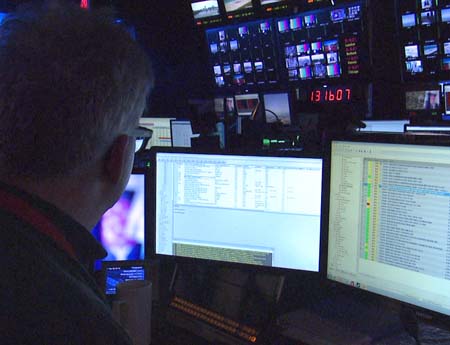For Efficiencies, Companies Look to Work Their Magic

The ongoing drive for more efficient operations capable of delivering more content to multiple platforms is pushing networks and station groups to deploy overarching software and production systems designed to better manage their workflows and operations.
Grass Valley’s Stratus media workflow framework offering has been adopted by the NBC owned stations in Dallas and Los Angeles, while Sinclair Broadcast Group is using systems from Masstech to better share content. Sony reports that its Media Backbone solutions are being installed at some of the Gray and Gannett stations as well as a number of regional sports networks.
“Everyone is looking for ways to create more efficient workflows as their operations get more complex and work to immediately distribute content to multiple platforms,” says Ali Etezadi-Amoli, senior manager, product management at Sony Electronics.
To tap into that demand, a number of vendors will be upgrading their software and workflow applications at this year’s NAB Show, beginning April 5 in Las Vegas.
Upgrades Will Be Flush in Vegas
Dana Ruzicka, VP of segment and product marketing at Avid, explains that last year the company rolled out its “Avid Everywhere” strategic vision “for a common services platform that ties together content creation all the way to content distribution and monetization and does all the heavy lifting for creating content, going to air and distributing and monetizing the content.”
Building on that vision, Avid will be rolling out its first products specifically created for Avid Everywhere at the NAB Show. “We have talked a lot about the vision and what you will see at NAB is real product and technologies,” Ruzicka says.
The smarter way to stay on top of broadcasting and cable industry. Sign up below
At NAB, Bitcentral will also be showcasing upgrades to its CORE:news solutions, including features that allow users to access it within newsroom computer systems such as ENPS and iNews, says Rick Young, VP of sales and product strategy at Bitcentral, which has deployed its workflow solutions at a number of station groups.
“We want to break down the walls and all these silos in news production,” Young says, by introducing new tools for streamlining field acquisition, better sharing of content between stations and better integration with other news production systems.
A key part of the effort to streamline workflows is cloud-based solutions. Adobe, Aframe, Panasonic, Sony, JVC, Avid, Bitcentral, Grass Valley and others have launched or will be launching systems that allow users to access, edit and create content via the cloud.
With Grass Valley’s Edius editing software and Stratus media workflow framework, for example, users can edit and share content via the cloud. “We want to give them access to not only their own content in the field or newsroom but content that is in archive or elsewhere on the network,” says Matt Allard, VP of marketing operations at Grass Valley.
Stories Are King
As stations and networks produce more content for more platforms, Raoul Cospen, director of marketing and business development, Dalet Digital Media Systems, argues that moving to asset or “story-centric” workflows can considerably streamline the process of multiplatform delivery by automating many of the processes. “You don’t need different people for the TV and Web because the journalist is responsible for the entire product,” Cospen says.
Better connectivity and improved workflow tools are also helping companies reduce the amount of people that networks need to send to major productions such as the Olympics. NBCUniversal was able to reduce the number of people it sent to Sochi by using the Harmonic MediaGrid shared storage and Spectrum MediaDeck integrated media playout server to run its “highlights factory” out of the broadcaster’s Stamford, Conn., facility, says Matthew Rehrer, Harmonic product manager. “It was the first time they weren’t flying people to the venues to handle the highlights factory,” which produced clips for the digital platforms, Rehrer adds.
This upgrade offers producers better access to raw footage, and over time can significantly change the way remote productions are done.
“By creating a more connected workflow, you are able to use resources from the home base and have access to content from the trucks from afar,” says Jay Deutsch, senior director of projects and systems architecture for the Americas at EVS. “By integrating a facility with distant productions, you will start to see in the next year or two a real revolutionary change in the way live production is produced.”
DAYTIME TAKES CUE FROM SPORTS
In recent years, when it comes to streamlined workflows, daytime entertainment producers have learned things by example—from sports. ABC has been using technologies developed by EVS Broadcast Equipment for a number of shows, including The Chew, The View and Katie, to speed up the process of production.
“When we were looking at how to implement quick-turnaround workflows, the fact that EVS was so active in sports and news where you need very fast turnarounds was an important consideration,” says David Linick, manager, broadcast engineering at ABC broadcast operations and engineering.
While The Chew doesn’t air live, Barry Gingold, post-production producer at ABC Entertainment Group-Daytime, adds that “we record from 9 to 10 in the morning and have to deliver the show by 10:30, so being able to handle a short turnaround has been very helpful.”
The technology has also been adapted for entertainment production. “When you have a dozen people who have been working on a show, you need to be able to integrate into their systems and not ask them to turn their workflows upside down,” says Jay Deutsch, senior director of projects and systems architecture for the Americas at EVS, which deployed EVS XS chasses, XT3 server and IPDirector for The Chew.
